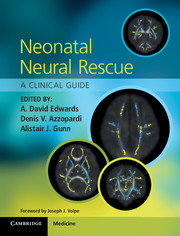Book contents
- Frontmatter
- Contents
- List of contributors
- Foreword
- Section 1 Scientific background
- Section 2 Clinical neural rescue
- 6 Challenges for parents and clinicians discussing neuroprotective treatments
- 7 The pharmacology of hypothermia
- 8 Selection of infants for hypothermic neural rescue
- 9 Hypothermia during patient transport
- 10 Whole body cooling for therapeutic hypothermia
- 11 Selective head cooling
- 12 Hypothermic neural rescue for neonatal encephalopathy in mid- and low-resource settings
- 13 Cerebral function monitoring and EEG
- 14 Magnetic resonance imaging in hypoxic–ischaemic encephalopathy and the effects of hypothermia
- 15 Novel uses of hypothermia
- 16 Neurological follow-up of infants treated with hypothermia
- 17 Registry surveillance after neuroprotective treatment
- Section 3 The future
- Index
- References
11 - Selective head cooling
from Section 2 - Clinical neural rescue
Published online by Cambridge University Press: 05 March 2013
- Frontmatter
- Contents
- List of contributors
- Foreword
- Section 1 Scientific background
- Section 2 Clinical neural rescue
- 6 Challenges for parents and clinicians discussing neuroprotective treatments
- 7 The pharmacology of hypothermia
- 8 Selection of infants for hypothermic neural rescue
- 9 Hypothermia during patient transport
- 10 Whole body cooling for therapeutic hypothermia
- 11 Selective head cooling
- 12 Hypothermic neural rescue for neonatal encephalopathy in mid- and low-resource settings
- 13 Cerebral function monitoring and EEG
- 14 Magnetic resonance imaging in hypoxic–ischaemic encephalopathy and the effects of hypothermia
- 15 Novel uses of hypothermia
- 16 Neurological follow-up of infants treated with hypothermia
- 17 Registry surveillance after neuroprotective treatment
- Section 3 The future
- Index
- References
Summary
Introduction
There is now overwhelming clinical evidence that mild to moderate post-asphyxial cerebral cooling can be associated with long-term neuroprotection, as reviewed in Chapter 4 and previous meta-analyses [1]. The key requirements for protection in clinical and preclinical studies are that hypothermia be initiated as soon as possible in the latent phase, within the first 6 hours, before secondary deterioration and that it be continued for a sufficient period in relation to the evolution of delayed encephalopathic processes, typically 48 hours or more (Chapter 7). Despite this remarkable progress, the optimal mode of cooling remains unresolved. Although the majority of clinical trials of therapeutic hypothermia have involved whole body cooling, much of the preclinical development of hypothermia was focused on head cooling with mild systemic hypothermia and the CoolCap (Natus Ltd, OR) remains the only system to have received FDA registration for treatment of hypoxic–ischaemic encephalopathy (HIE). The present chapter highlights the evidence for head cooling, outlines the technical procedures and critically reviews the evidence for its safety and effectiveness.
Cooling the head “selectively”
To provide neuroprotection with the least possible risk of systemic adverse effects in sick, unstable neonates, ideally we would cool only the brain. Although this has been achieved experimentally using cardiac bypass procedures [2], it is clearly impractical in routine practice. Pragmatically, partially selective cerebral cooling can be obtained using a cooling cap applied to the scalp while the body is warmed by some method such as an overhead heater to limit the degree of systemic hypothermia [3–5]. In practice, mild systemic hypothermia is desirable during head cooling, first to limit the steepness of the intracerebral gradient that would otherwise be needed (and thus avoiding the need for excessively cold cap temperatures) [6] and second to provide greater cooling of the brain stem. In the piglet, this approach has been demonstrated to achieve a substantial (median, 5.3°C) sustained decrease in deep intracerebral temperature at the level of the basal ganglia compared with the rectal temperature [7,8]. Similar results during brief head cooling have been reported by others in the fetal sheep [9], young adult cat [10], the newborn rat [11] and the piglet [12]. Although direct temperature measurements are not feasible in asphyxiated newborns, head cooling has been shown to increase the gradient between nasopharyngeal temperature, an index of the temperature at the base of the brain, and rectal temperature by nearly 1°C [3].
- Type
- Chapter
- Information
- Neonatal Neural RescueA Clinical Guide, pp. 119 - 127Publisher: Cambridge University PressPrint publication year: 2013



